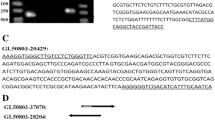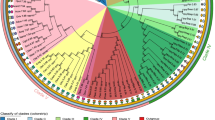Abstract
The majority of eukaryotic genes consist of exons and introns. Introns can be inserted either between codons (phase 0) or within codons, after the first nucleotide (phase 1) and after the second (phase 2). We report here that the frequency of phase 0 increases and phase 1 declines from the 5′ region to the 3′ end of genes. This trend is particularly noticeable in genomes of Homo sapiens and Arabidopsis thaliana, in which gains of novel introns in the 3′ portion of genes were probably a dominant process. Similar but more moderate gradients exist in Drosophila melanogaster and Caenorhabditis elegans genomes, where the accumulation of novel introns was not a prevailing factor. There are nine types of exons, three symmetric (0,0; 1,1; 2,2) and six asymmetric (0,1; 1,0; 1,2; 2,1; 2,0; 0,2). Assuming random distribution of different types of introns along genes, one can expect the frequencies of asymmetric exons such as 0,1 and 1,0 or 1,2 and 2,1 to be approximately equal, allowing for some variation caused by randomness. The gradient in intron distribution leads to a small but consistent and statistically significant bias: phase 1 introns are more likely at the 5′ ends and phase 0 introns are more likely at the 3′ ends of asymmetric exons. For the same reason, the frequency of 0,0 exons increases and the frequency of 1,1 exons decreases in the 3′ direction, at least in H. sapiens and A. thaliana. The number of introns per gene also affects the distribution and frequency of phase 0 and 1 introns. The gradient provides an insight into the evolution of intron-exon structures of eukaryotic genes.


Similar content being viewed by others
References
Coghlan A, Wolfe KH (2004) Origins of recently gained introns in Caenorhabdiditis. Proc Natl Acad Sci USA 101:11362–11367
Endo T, Fedorov A, de Souza SJ, Gilbert W (2002) Do introns favor or avoid regions of amino acid conservation? Mol Biol Evol 19:521–525
Fedorov A, Suboch G, Bujakov M, Fedorova L (1992) Analysis of nonuniformity in intron phase distribution. Nucleic Acids Res 20:2553–2557
Gilbert W, de Souza SJ, Long M (1997) Origin of genes. Proc Natl Acad Sci USA 94:7698–7703
Kaessmann H, Zöllner S, Nekrutenko A, Li W-H (2002) Signatures of domain shuffling in the human genome. Genome Res 12:1642–1650
Lercher MJ, Chamary JV, Hurst LD (2004) Genomic regionality in rates of evolution is not explained by clustering of genes of comparable expression profile. Genome Res 14:1002–1013
Long M, Deutsch M (1999) Association of intron phases with conservation at splice site sequences and evolution of spliceosomal introns. Mol Biol Evol 16:1528–1534
Long M, Rosenberg C (2000) Testing the “proto-splice sites” model of intron origin:evidence from analysis of intron phase correlations. Mol Biol Evol 17:1789–1796
Long M, Rosenberg C, Gilbert W (1995) Intron phase correlations and the evolution of the intron/exon structure of genes. Proc Natl Acad Sci USA 92:12495–12499
Lynch M (2002) Intron evolution as a population–genetic process. Proc Natl Acad Sci USA 99:6118–6123
Nguyen HD, Yoshihama M, Kenmochi N (2005) New maximum likelihood estimators for eukaryotic intron evolution. PloS Comput Biol 1:0631–0638 (http://www.ploscomp.biol.org)
Qui W-G, Schisler N, Stoltzfus A (2004) The evolutionary gain of spliceosomal introns:sequence and phase preferences. Mol Biol Evol 21:1252–1263
Rogozin IB, Wolf YI, Sorokin AV Mirkin BV, Koonin EV (2003) Remarkable interkingdom conservation of intron positions and massive, lineage-specific intron loss and gain in eukaryotic evolution. Curr Biol 13:1512–1517
Rogozin IB, Sverdlov AV, Babenko VN, Koonin EV (2005) Analysis of evolution of exon-intron structure of eukaryotic genes. Brief Bioinform 6:118–134
Roy SW, Gilbert W (2005) Rates of intron loss and gain:implications for early eukaryotic evolution. Proc Natl Acad Sci USA 102:5773–5778
Ruvinsky A, Eskesen ST, Eskesen FN, Hurst LD (2005) Can codon usage bias explain intron phase distributions and exon symmetry? J Mol Evol 60:99–104
Saxonov S, Daizadeh I, Fedorov A, Gilbert W (2000) EID: the Exon–Intron Database—an exhaustive database of protein-coding intron-containing genes. Nucleic Acids Res 28:185–190
Sverdlov AV, Babenko VN, Rogozin IB, Koonin EV (2004) Preferential loss and gain of introns in 3′ portion of genes suggests a reverse-transcription mechanism of intron insertion. Gene 338:84–91
Tordai H, Patthy L (2004) Insertion of spliceosomal introns in proto-splice sites: the case of secretory signal peptides. FEBS Lett 575:109–111
Vibranovski MD, Sakabe NJ, de Oliveira RS, de Souza SJ (2005) Signs of ancient and modern exon-shuffling are correlated to the distribution of ancient and modern domains along proteins. J Mol Evol 61:341–350
Acknowledgments
The authors are grateful to J.-V. Chamary for the purging of the database used in this study and to L. Hurst for the useful discussion.
Author information
Authors and Affiliations
Corresponding author
Additional information
[Reviewing Editor: Dr. Manyuan Long]
Electronic Supplementary Material
Rights and permissions
About this article
Cite this article
Ruvinsky, A., Ward, W. A Gradient in the Distribution of Introns in Eukaryotic Genes. J Mol Evol 63, 136–141 (2006). https://doi.org/10.1007/s00239-005-0261-6
Received:
Accepted:
Published:
Issue Date:
DOI: https://doi.org/10.1007/s00239-005-0261-6




